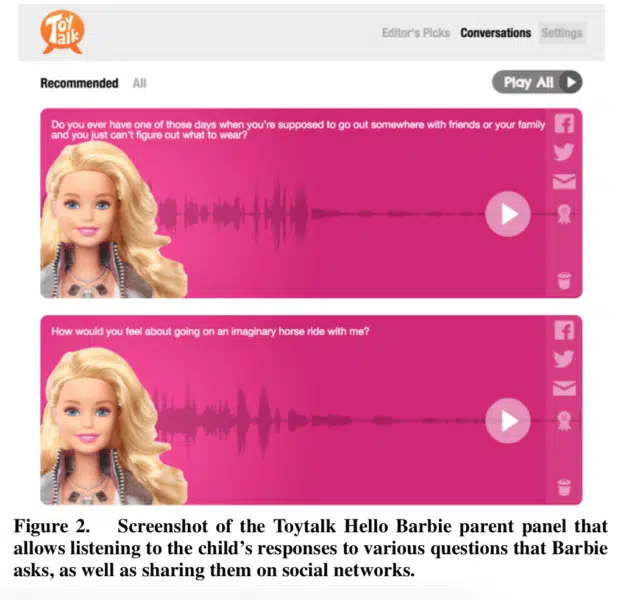FTC PrivacyCon: How lessons learned by toy designers can inform marketers’ privacy policies
Are privacy concerns around connected toys a sign of what's to come as IoT explodes?
Robin Kurzer on February 28, 2018 at 4:25 pm | Reading time: 3 minutes
 Did you know that your child’s Barbie doll might be listening, saving and readying itself to transmit everything your child is saying to her? In a talk at the Federal Trade Commission’s annual PrivacyCon this morning, Emily McReynolds of the University of Washington Tech Policy Lab, presented a paper discussing the thorny issues surrounding privacy and connected devices like smart toys and voice assistants.
McReynolds and her team studied parents and children using toys that promote interaction through the use of interactive voice features, such as Hello Barbie and CogniToys Dino. The paper provided recommendations to toy designers and policy makers about how they can produce interactive objects without exploiting user privacy rights.
When a child pushes the belt buckle on a Hello Barbie, it activates a feature where it captures conversation via a Wifi-enabled recorder and saves it to a control center, while using speech-recognition software to deliver a canned answer. Parents can access these “conversations” via a dashboard and have several options, including to delete and share on social media.
According to the report, the parents interviewed were sensitive to the issues surrounding monitoring what their child does with the toy as well as what data would be retained by the company. And in the interest of consent, some parents felt a need to explain to their kids that the toy was, in fact, recording them. All of the parents said they would not share the information on social media.
Did you know that your child’s Barbie doll might be listening, saving and readying itself to transmit everything your child is saying to her? In a talk at the Federal Trade Commission’s annual PrivacyCon this morning, Emily McReynolds of the University of Washington Tech Policy Lab, presented a paper discussing the thorny issues surrounding privacy and connected devices like smart toys and voice assistants.
McReynolds and her team studied parents and children using toys that promote interaction through the use of interactive voice features, such as Hello Barbie and CogniToys Dino. The paper provided recommendations to toy designers and policy makers about how they can produce interactive objects without exploiting user privacy rights.
When a child pushes the belt buckle on a Hello Barbie, it activates a feature where it captures conversation via a Wifi-enabled recorder and saves it to a control center, while using speech-recognition software to deliver a canned answer. Parents can access these “conversations” via a dashboard and have several options, including to delete and share on social media.
According to the report, the parents interviewed were sensitive to the issues surrounding monitoring what their child does with the toy as well as what data would be retained by the company. And in the interest of consent, some parents felt a need to explain to their kids that the toy was, in fact, recording them. All of the parents said they would not share the information on social media.

Clear communication helps
The report recommends that toy designers and policy makers provide clearer communication around recording, including visual indicators. It also suggests that toy designers re-evaluate their need to record and store information at all. I tweeted a question to the live panel, asking if the children who are growing up using these devices — tomorrow’s adult consumers — will have a different sense of data privacy. “I think that it’s all about the discussion you have with these devices,” McReynolds said. “I think you are seeing kids grow up much more connected than they ever have before. We know that because we’re in this era where we always have little computers in our pockets at all time. It’s an education effort like anything else when a kid is growing up. They’ll be more connected and more in tune with devices than before, but the same conversations around privacy can happen.”Opinions expressed in this article are those of the guest author and not necessarily MarTech. Staff authors are listed here.
Related stories